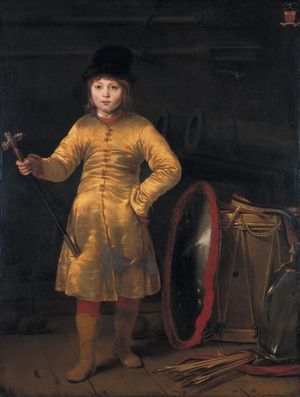Difference between revisions of "Fantastic Forgeries"
H.van.Beek (talk | contribs) |
H.van.Beek (talk | contribs) |
||
| Line 8: | Line 8: | ||
The underscript was: This painting shows a boy in Polish costume holding a war hammer. On the floor are a shield, a drum, a 'cuirass' or armoured breastplate and a bow and quiver of arrows. In the background are two cannons with accompanying ramrods and wiper. The boy is Otto van der Waeyen, the son of an Amsterdam based weapons trader who had contacts with Poland. | The underscript was: This painting shows a boy in Polish costume holding a war hammer. On the floor are a shield, a drum, a 'cuirass' or armoured breastplate and a bow and quiver of arrows. In the background are two cannons with accompanying ramrods and wiper. The boy is Otto van der Waeyen, the son of an Amsterdam based weapons trader who had contacts with Poland. | ||
| − | At first I only saw the letters and the words, just like all the other descriptions of all the work in the Boijmans. But then it came to me. In the year 1600, a Dutch weapon trader earned enough from the war in | + | At first I only saw the letters and the words, just like all the other descriptions of all the work in the Boijmans. But then it came to me. In the year 1600, a Dutch weapon trader earned enough from the war in Poland with Russia to let his son and his merchandise get painted by a master painter. |
Revision as of 12:43, 16 September 2014
Authourship & Authenticity Project: Museum Of Fantastic Forgeries
OTTO'S HAMMER
In the introduction assignment Make from the Museum we did some scouting in the Boijmans. In that introduction my eye fell on a work from Ferdinand Bol.
The underscript was: This painting shows a boy in Polish costume holding a war hammer. On the floor are a shield, a drum, a 'cuirass' or armoured breastplate and a bow and quiver of arrows. In the background are two cannons with accompanying ramrods and wiper. The boy is Otto van der Waeyen, the son of an Amsterdam based weapons trader who had contacts with Poland.
At first I only saw the letters and the words, just like all the other descriptions of all the work in the Boijmans. But then it came to me. In the year 1600, a Dutch weapon trader earned enough from the war in Poland with Russia to let his son and his merchandise get painted by a master painter.
